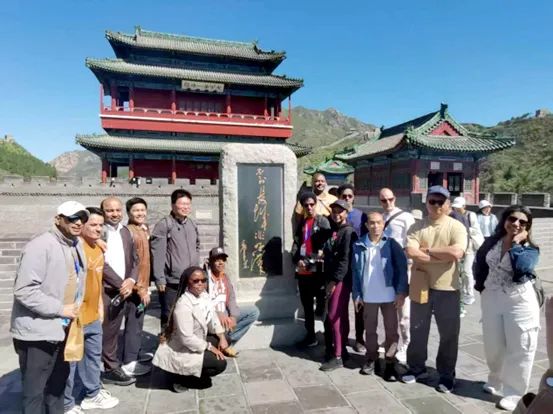Steps of Stone, Stories of Strength, An experience from the Great Wall of China
 Standing atop one of the world’s most iconic landmarks — the Great Wall of China — was nothing short of surreal. Stretching across mountain ridges and winding through breathtaking landscapes, this architectural marvel speaks volumes about China’s rich history, cultural depth, and enduring spirit. I had the privilege to witness it all, thanks to the China International Press Communication Center (CIPCC).
Standing atop one of the world’s most iconic landmarks — the Great Wall of China — was nothing short of surreal. Stretching across mountain ridges and winding through breathtaking landscapes, this architectural marvel speaks volumes about China’s rich history, cultural depth, and enduring spirit. I had the privilege to witness it all, thanks to the China International Press Communication Center (CIPCC).
As part of the 2025 CIPCC media exchange program, I joined over 120 journalists from more than 100 countries — a record-breaking edition since the initiative’s launch in 2014. Representing Huashang News, it was an honour to be included in this diverse global group exploring China’s heritage through firsthand experience. For someone who comes from a region with its own rugged beauty and historical richness, this was an opportunity to view the world through a different lens — one shaped by centuries of resilience and progress.
The Great Wall is more than a structure; it’s a story — and not just one, but many interwoven through time. Originally constructed to defend Chinese territories from northern invasions, the wall’s earliest segments date back to the 7th century BC. Over the centuries, it was expanded and fortified by successive dynasties, notably the Qin, Han, and Ming, each contributing their own techniques, visions, and purposes.
What we see today — the strong stonework and imposing battlements — largely dates to the Ming Dynasty (1368–1644), when the Wall reached its most formidable state. Spanning approximately 8,850 kilometers, it was a marvel of military strategy. It included walls, trenches, rivers as barriers, watchtowers, beacon towers, barracks, and garrisons. The Wall wasn’t merely about stopping invaders; it was about signaling the world that China was a civilization capable of extraordinary feats of construction and unity.

The laborers who built it — soldiers, farmers, peasants, artisans, and even prisoners — endured harsh conditions, often working under extreme weather, limited food supplies, and physical strain. Many died during its construction, and legends describe it as “the longest cemetery on earth.” It stands today as a monument not only to architectural genius but to human endurance and sacrifice.
Climbing the Wall wasn’t a casual stroll — it was a challenge, both physical and emotional. The stairs were steep, uneven, and at times almost vertical. Each step demanded patience, balance, and strength. As I ascended, I noticed the unique wear of each stone — polished smooth in places by millions of feet across generations. I paused at intervals, not just to catch my breath but to reflect.
My journey upward mirrored the journey of those who had built it centuries ago. While I faced no arrows, no physical threat, I did feel the burden of gravity and time. The higher I climbed, the more I felt connected to those whose labor and vision had birthed this marvel. The pain in my legs and the sweat on my brow became symbols of respect — small offerings to the memory of the past.
The view at the top was more than just a panorama. It was a realization: of how small we are in the face of such grandeur, and yet how capable humanity is of achieving the impossible when united by purpose.
I documented every moment — through photos, videos, and a short video journal — not merely to share with readers back home, but to preserve a memory that would forever remain etched in my identity. I stood alongside journalists from Africa, Europe, and other parts of Asia, each of us smiling into the camera, feeling the same awe. Our backgrounds differed, but our emotions mirrored one another. Awe knows no nationality.
In one memorable moment, a fellow journalist, breathless and beaming, turned to me and said, “This isn’t just a wall — it’s a journey through time.” That sentiment lingered with me. The Wall, in many ways, encapsulates human history: struggle, perseverance, defense, and pride.
The Great Wall is deeply embedded in the Chinese psyche. It is not only a UNESCO World Heritage Site but a symbol of national pride. Schoolchildren grow up learning about its significance, artists depict it in literature and paintings, and it has featured prominently in national holidays, films, and even international diplomacy.
During our visit, Chinese guides and historians enriched our understanding, offering stories that textbooks might miss — tales of bravery, of communities formed around watchtowers, and of strategies devised from these high vantage points. We were reminded that the Wall was not just a defense against physical invasion but a cultural statement to the world: “We are strong. We are united. We endure.”
The CIPCC media program was not just a trip; it was a dialogue. It offered a rare opportunity to witness China not through filtered headlines, but through authentic encounters. We visited local communities, interacted with Chinese students, explored museums, and engaged in thoughtful discussions about journalism, misinformation, and cultural narratives.
Each day brought new experiences: tea ceremonies that taught us patience and presence, museum visits that contextualized China's dynasties, modern technology parks that revealed how the nation is simultaneously steeped in tradition and reaching toward the future. The seamless blend of past and present was evident everywhere — from ancient alleyways in Beijing to the AI-powered newsrooms.
As a journalist, I’m often driven by deadlines, headlines, and deadlines again. But standing on the Great Wall, I felt something shift. Journalism, at its core, is about storytelling — and this place had stories carved into every stone. I began to think more deeply about the kind of narratives we share with the world. Are we preserving the past while embracing the future? Are we building bridges or walls with our words?
The experience reminded me that to tell the truth, one must first seek it — not just through research, but through presence. Being there, touching history, breathing the mountain air, speaking with those who live it — that’s when journalism transcends reporting and becomes understanding.
As I looked out across the horizon from the highest point of our climb, I thought of home. I thought of the mountains of Balochistan, where history also whispers through stones and wind. Though our regions are different, the values — resilience, honor, and community — felt deeply familiar.
Coming from Pakistan, and especially the rugged, history-rich province of Balochistan, the Great Wall resonated with me on a personal level. Our region too is dotted with remnants of ancient civilizations — from the Mehrgarh archaeological site near Bolan to the centuries-old fortresses in Kalat and Khuzdar. The mountains of Balochistan hold stories of warriors, tribal leaders, and caravan routes that once connected South Asia to Central Asia and the Middle East.
I thought of future generations and what kind of legacies we are building for them. What will they inherit from us? Walls of separation, or bridges of connection?
Our landscapes differ, the Great Wall reminded me of the resilience of my own people — and the untold stories waiting to be shared with the world.
This visit to the Great Wall marked just the beginning. I’m only 20 days into a three-and-a-half-month journey through China, and already I feel transformed.
I’m eager to continue exploring China’s multifaceted identity — its economic rise, its grassroots cultures, its ecological efforts, and its historical treasures. I look forward to telling these stories not just as an observer, but as a participant — a journalist walking alongside history, not behind it.
The Great Wall of China is often referred to as one of the Seven Wonders of the Medieval World. But after experiencing it, I believe it transcends even that title. It is a global monument — one that speaks to anyone who believes in strength, in legacy, in unity. It speaks to me as a Pakistani, as a journalist, and as a citizen of the world.
The journey, the climb, the stories shared, and the bonds formed — all of these have left a permanent mark on me. As I continue this adventure with CIPCC, I carry with me the lessons learned on those steep, ancient steps: that true strength lies not in stone, but in spirit. And that some walls, instead of dividing us, teach us how deeply connected we all truly are.
This is not the end of my story in China. It is the beginning of many stories I hope to tell — stories of strength, of culture, of shared humanity. The stones of the Great Wall may be ancient, but the inspiration they spark is forever fresh.

